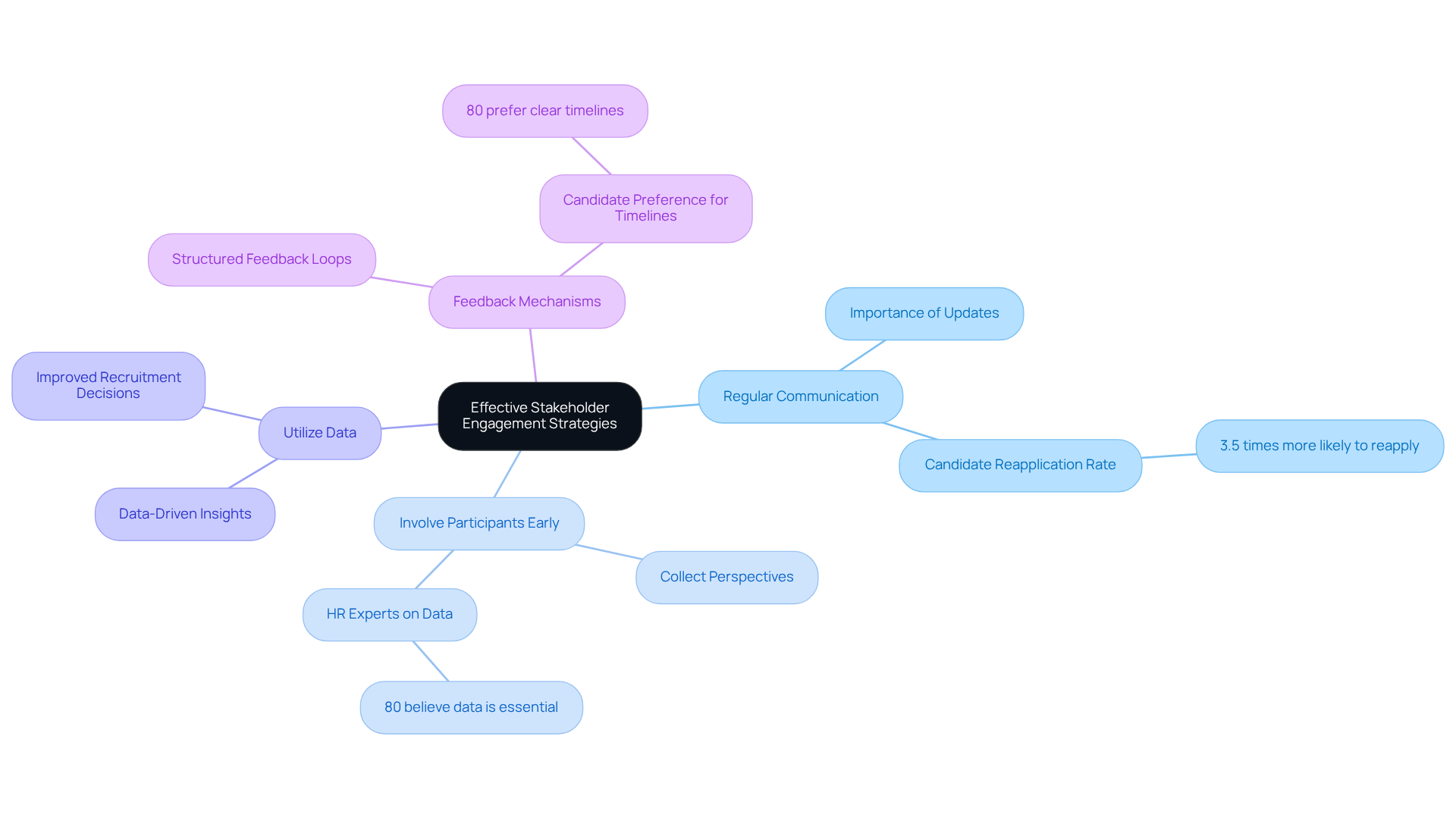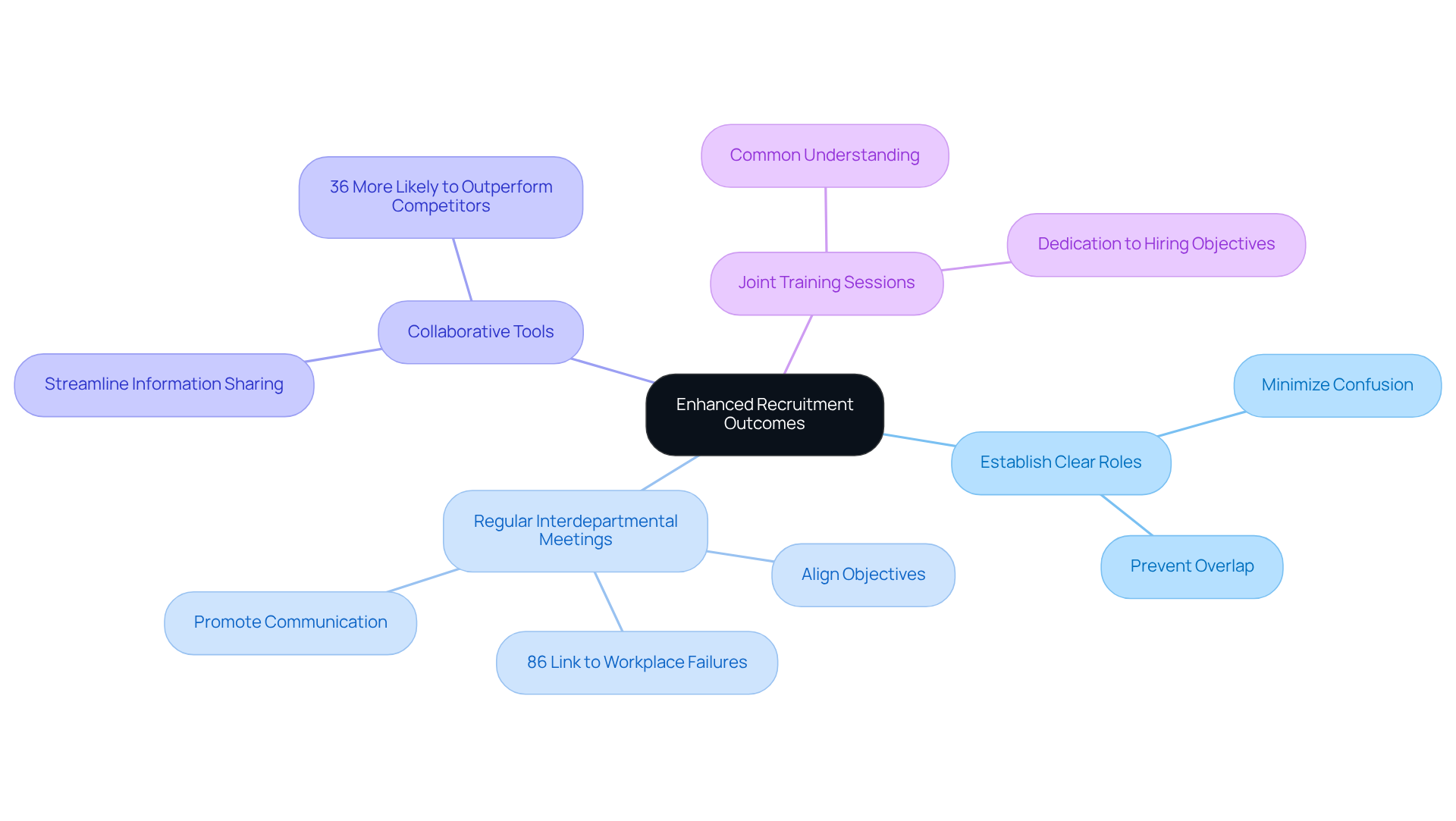Overview
This article presents four pivotal strategies for effective stakeholder management in talent acquisition. It emphasizes the necessity of:
- Regular communication
- The early involvement of participants
- The strategic utilization of data
- The implementation of structured feedback mechanisms
Evidence supports these strategies, demonstrating that robust stakeholder engagement can significantly enhance recruitment outcomes, elevate candidate experiences, and align hiring processes with organizational objectives. Consequently, this alignment can lead to a reduction in costs associated with poor hiring decisions. Stakeholders must recognize the value of these strategies and actively engage in their application to achieve optimal recruitment results.
Introduction
Effective stakeholder management in talent acquisition is not merely a best practice; it is a strategic necessity that can significantly impact recruitment efforts. Organizations that excel in this domain can seamlessly align their hiring strategies with broader business objectives, ensuring that each hire plays a vital role in the company's success.
However, despite its critical importance, many companies face challenges in effectively engaging stakeholders, resulting in costly hiring errors and missed opportunities.
What key strategies can transform stakeholder relationships into a powerful asset for talent acquisition?
Understand Stakeholder Management in Talent Acquisition
Effective stakeholder management in talent acquisition is crucial for aligning hiring strategies with organizational objectives. It involves recognizing all parties in the recruitment process, including managers, HR staff, and external collaborators. Understanding their roles and expectations is vital; effective stakeholder management in talent acquisition ensures consensus, significantly enhancing the recruitment process. For instance, a clear grasp of the manager's needs can lead to more focused job descriptions and targeted candidate searches, ultimately improving the quality of hires. Poor recruitment decisions can cost employers three to four times the role's salary, emphasizing the financial implications of stakeholder management in talent acquisition.
To effectively manage interested parties, organizations should analyze these groups, categorizing them based on their influence and interest in the hiring process. This analysis enables prioritization of engagement efforts and customization of communication strategies. Current trends indicate that 76% of recruitment managers expect AI to significantly transform selection processes, emphasizing the need for a balanced approach that integrates technology with human insight. Effective stakeholder management in talent acquisition involves regular communication between recruiters and management, fostering trust and collaboration, which can enhance offer and acceptance rates. Furthermore, efficient management of involved parties can facilitate internal mobility, aligning with contemporary trends in talent acquisition. By investing in strong relationships with stakeholders, organizations can enhance their stakeholder management in talent acquisition, streamline their hiring processes, and improve overall recruitment outcomes.

Implement Effective Stakeholder Engagement Strategies
To effectively engage stakeholders in the talent acquisition process, organizations must implement several key strategies:
-
Regular Communication: Establish a consistent schedule for updates and feedback sessions with involved parties. This approach to stakeholder management in talent acquisition ensures that stakeholders remain informed about hiring procedures and any modifications that may occur, fostering transparency and trust. Notably, candidates who are notified of their outcomes are 3.5 times more likely to reapply for a different position with the same company, underscoring the critical importance of communication.
-
Involve Participants Early: Engage parties from the outset of the hiring process. Collecting their perspectives and expectations early on can significantly influence the hiring approach, aligning it with organizational objectives and the principles of stakeholder management in talent acquisition. More than 80% of HR experts believe that examining data is essential for making sound recruitment choices, emphasizing the importance of participant input in developing data-informed strategies.
-
Utilize Data: Leverage data-driven insights to support recruitment decisions. Presenting relevant statistics and analytics not only substantiates the effectiveness of strategies employed in stakeholder management in talent acquisition but also aids interested parties in understanding the rationale behind recruitment choices. For instance, organizations that implement data-driven methods can make improved recruitment decisions, reduce biases, and enhance the candidate experience.
-
Feedback Mechanisms: Implement structured feedback loops that enable stakeholders to share their viewpoints on the recruitment system. This continuous feedback nurtures a culture of collaboration and promotes ongoing enhancements in stakeholder management in talent acquisition practices. A case analysis on the significance of explicit recruitment timelines shows that over 80% of candidates prefer having a clear schedule for the selection process, highlighting the necessity for openness and prompt communication.
By adopting these strategies, organizations can improve stakeholder management in talent acquisition, fostering a collaborative environment that enhances involvement and commitment in hiring efforts, ultimately leading to better employment outcomes.

Measure and Evaluate Stakeholder Relationships for Continuous Improvement
To drive continuous improvement in stakeholder management, organizations should adopt the following strategies:
- Participant Surveys: Regularly conducting surveys to evaluate participant satisfaction and gather feedback on their experiences throughout the recruitment process is essential. This practice not only identifies areas for improvement but also encourages a sense of participation among interested parties. Significantly, 40% of new employees depart their positions within the first 12 months, underscoring the importance of effective management in enhancing retention.
- Performance Metrics: Establishing key performance indicators (KPIs) that reflect participant engagement is crucial, including response times, satisfaction scores, and the quality of hires. For example, the typical expense per hire in the US is $4,700, and monitoring metrics such as Time to Fill and Quality of Hire can provide measurable insights into the efficiency of hiring processes and collaboration with involved parties.
- Regular Review Meetings: Arranging periodic gatherings with interested parties to assess performance metrics, share insights, and discuss necessary adjustments to strategies ensures alignment between recruitment goals and participant expectations. For instance, MyTutor expanded its hiring ability by 75% through enhanced methods, showcasing the effect of consistent interaction.
- Adaptation and Flexibility: Staying receptive to modifying engagement strategies based on participant feedback and changing requirements is essential. This flexibility is crucial for maintaining alignment with organizational objectives and enhancing the overall hiring process. However, organizations should be cautious not to neglect candidate experience in the pursuit of efficiency, as this can lead to negative outcomes.
By systematically assessing and analyzing stakeholder relationships, organizations can improve stakeholder management in talent acquisition, fostering a culture of ongoing enhancement that ultimately boosts hiring effectiveness and stakeholder satisfaction. As Elizabeth Parker observes, assessing hiring success is essential for optimizing resources and making data-driven decisions.

Foster Cross-Departmental Collaboration for Enhanced Recruitment Outcomes
To enhance cross-departmental collaboration in talent acquisition, organizations can adopt the following best practices:
- Establish Clear Roles: Clearly define the roles and responsibilities of each department involved in the hiring procedure to minimize confusion and prevent overlap.
- Regular Interdepartmental Meetings: Arrange regular gatherings that involve representatives from all pertinent departments to discuss hiring strategies, share insights, and align objectives. This practice not only promotes communication but also improves the overall efficiency of the hiring system. Notably, 86% of employees and executives link workplace failures to a lack of collaboration or ineffective communication.
- Collaborative Tools: Leverage technology platforms that facilitate collaboration, such as shared project management tools and communication applications, to streamline information sharing. Organizations that embrace collaborative leadership are 36% more likely to outperform their competitors, underscoring the value of effective communication tools.
- Joint Training Sessions: Implement training sessions that involve multiple departments to ensure that all team members comprehend the hiring process and their specific roles within it. This method fosters a common understanding and dedication to the hiring objectives.
By encouraging cross-departmental cooperation, organizations can create a unified hiring strategy that emphasizes stakeholder management in talent acquisition, leveraging the diverse strengths and insights of various teams, ultimately resulting in enhanced hiring outcomes. Research indicates that well-coordinated, collaborative teams are 50% more efficient at completing tasks, making this approach invaluable in achieving recruitment success. Additionally, connected teams significantly boost a company’s bottom line, showing a 21% increase in profitability compared to less-connected teams. Furthermore, team members in high collaboration jobs report nearly a 30% increase in job satisfaction, which is crucial for retention and productivity. Notably, 83% of companies use cross-functional teams to stay nimble and maintain a competitive edge, highlighting the necessity of such teams in modern organizations.

Conclusion
Effective stakeholder management in talent acquisition is essential for aligning recruitment processes with organizational goals and ensuring a successful hiring outcome. By recognizing and engaging all parties involved—such as managers, HR staff, and external collaborators—organizations can create a cohesive strategy that enhances the quality of hires and minimizes costly recruitment errors.
The article outlines several key strategies for achieving effective stakeholder management. These include:
- Regular communication
- Early involvement of participants
- Data-driven decision-making
- Structured feedback mechanisms
Such approaches not only foster trust and collaboration among stakeholders but also lead to improved recruitment processes and better retention rates. Moreover, the importance of cross-departmental collaboration is highlighted, showcasing how unified efforts can significantly enhance hiring outcomes.
Ultimately, prioritizing stakeholder management in talent acquisition is not merely a best practice; it is a strategic necessity for organizations aiming to thrive in a competitive landscape. By embracing these strategies, companies can cultivate strong relationships with stakeholders, streamline their hiring processes, and achieve superior recruitment results. Investing in effective stakeholder engagement is a crucial step toward building a robust workforce that aligns with the organization's vision and objectives.
Frequently Asked Questions
What is stakeholder management in talent acquisition?
Stakeholder management in talent acquisition involves recognizing and aligning the interests of all parties involved in the recruitment process, such as managers, HR staff, and external collaborators, to enhance hiring strategies and organizational objectives.
Why is understanding stakeholder roles and expectations important?
Understanding stakeholder roles and expectations is vital because it ensures consensus among involved parties, leading to more focused job descriptions and targeted candidate searches, ultimately improving the quality of hires.
What are the financial implications of poor recruitment decisions?
Poor recruitment decisions can cost employers three to four times the salary of the role, highlighting the importance of effective stakeholder management in minimizing these costs.
How should organizations categorize stakeholders in the hiring process?
Organizations should analyze stakeholders based on their influence and interest in the hiring process, which helps prioritize engagement efforts and customize communication strategies.
What current trend is influencing recruitment managers?
A significant trend is that 76% of recruitment managers expect AI to transform selection processes, underscoring the need for a balanced approach that combines technology with human insight.
How can regular communication between recruiters and management benefit the recruitment process?
Regular communication fosters trust and collaboration, which can enhance offer and acceptance rates, making the recruitment process more efficient.
How does effective stakeholder management facilitate internal mobility?
Efficient management of involved parties can support internal mobility by aligning hiring practices with contemporary trends in talent acquisition, ultimately benefiting the organization.
What is the overall benefit of investing in relationships with stakeholders?
Investing in strong relationships with stakeholders enhances stakeholder management in talent acquisition, streamlines hiring processes, and improves overall recruitment outcomes.




